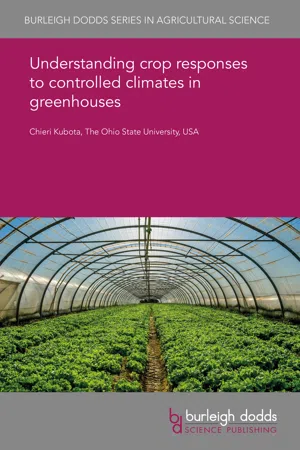
- English
- PDF
- Available on iOS & Android
Understanding crop responses to controlled climates in greenhouses
About this book
Understanding plant responses to environmental factors is crucial in controlled environment crop production. This chapter summarizes current understanding of interactions of key aerial environmental factors affecting plant growth and their strategic applications to improve the productivity, profitability and sustainability of greenhouse cultivation. It reviews the current body of knowledge regarding plant responses to environmental interactions. Environmental factors discussed include light intensity, temperature, air circulation, relative humidity and carbon dioxide concentration. Interactions of (1) light and temperature; (2) light and carbon dioxide; (3) light and plant canopy structure; (4) temperature and temperature integration time; and (5) humidity, air circulation and light are also presented (it must be noted there are many other combinations of factors, not only of aerial factors but also of root-zone factors). A case study is provided on tipburn management of strawberry using night-time humidity control. The chapter concludes with a look towards future trends in research.
Frequently asked questions
- Essential is ideal for learners and professionals who enjoy exploring a wide range of subjects. Access the Essential Library with 800,000+ trusted titles and best-sellers across business, personal growth, and the humanities. Includes unlimited reading time and Standard Read Aloud voice.
- Complete: Perfect for advanced learners and researchers needing full, unrestricted access. Unlock 1.4M+ books across hundreds of subjects, including academic and specialized titles. The Complete Plan also includes advanced features like Premium Read Aloud and Research Assistant.
Please note we cannot support devices running on iOS 13 and Android 7 or earlier. Learn more about using the app.
Information
Table of contents
- 1 Introduction
- 2 Research towards integrative optimizations and control of aerial environmental factors in greenhouses
- 3 Case study: intermittent night-time humidity in integration control can manage tipburn
- 4 Conclusion and future trends
- 5 Where to look for further information
- 6 References